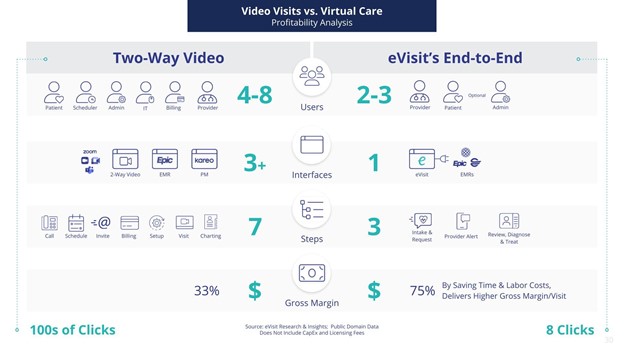Post-Pandemic Telehealth Pivot: Pick the Right Partner

Bret Larsen, Co-Founder & CEO, eVisit
When COVID-19 hit, healthcare providers turned to their Electronic Health Records (EHR) vendors to rapidly scale their virtual care capabilities, with many using two-way video only approaches. Results were mixed at best.
According to Gartner and its most recent research report on virtual care, healthcare providers are now moving from these fragmented and tactical solutions to establishing long-term, enterprise-wide strategic approaches to virtual care. In the pandemic, providers and leaders at Healthcare Organizations (HCOs) across the nation moved quickly to put smart approaches in place to ensure they could effectively care for patients. They quickly learned the difference between video visits and virtual care and are now seeking out partners to provide new robust solutions to help them quickly pivot.
With hundreds of telehealth vendors to choose from, sifting through the options is a daunting task. Here are six important considerations to keep in mind as you vet candidates and make your long-term virtual care partner decision.

#1 – Align on Shared Vision in Telehealth
Your telehealth partner’s vision influences everything about the way they design, execute and deliver their product. When you’re vetting potential telehealth partners, be sure to ask questions about their vision, mission and core values and make sure their answers line up with yours. Alignment is crucial and it should be fairly obvious — you know it when you feel it.
#2 – Look for an End-to-End Enterprise-Ready Solution
Your organization needs a purpose-built, end-to-end platform that integrates all activities in the virtual care workflow. The platform should virtualize every step in the care process including scheduling and intake, waiting room management, the virtual visit itself, ePrescribe and discharge, along with sophisticated analytics and reporting for enhanced Business Intelligence (BI). Each step must integrate with the next, and customization is key. The eVisit Research & Insights Team has analyzed the difference between video visits and virtual care and the results clearly show efficiencies and financial benefits of an end-to-end solution.

#3 – Seek Out Flexible Clinical Workflows
Your telehealth partner should offer virtual care solutions that are responsive to the patient’s needs, as well as support evolving use cases, changing clinical requirements and new business opportunities. You need a solution that can match your clinical workflow across a range of specialties, service lines and care offerings. If the virtual workflow is hard coded, that’s going to be problematic as flexibility is crucial in a long-term telehealth platform.
#4 – Find a Partner that Enables Your Provider Network, Not Theirs
Some telehealth platforms come with their own provider networks. These providers will compete with your providers for patients on the platform, which runs counter to your overall business goals and to retaining your patients and keeping them in-network. What’s more, these providers might not be located in your state. As such, they won’t be familiar with local healthcare resources, making them ill-suited to recommend follow-up care options, when and if needed. As we all know, fragmented and episodic care can lead to gaps in the continuum of care, and that’s not the best care for patients.
#5 – The Importance of Independent Reviews
As you shortlist partner organizations, review their customer list and talk with them about their virtual care projects, particularly at large-scale organizations with complicated workflows. If they have a robust reference list, that’s a great sign of customer success. Look for other independent and rigorous reviews, like those of industry analyst firms, who are all now working tirelessly — with the pandemic and the advancement of telehealth — to size the market, cite trends and earmark key players. Gartner, the world’s leading research and advisory company, recently published the Gartner 2020 Market Guide for Virtual Care Solutions specifically designed to help CIOs and healthcare leaders develop virtual care strategies and guide the procurement and vendor selection process. The Forrester Wave™: Virtual Care Platforms for Digital Health, Q1 2021 is a tremendously helpful and high-value analyst report too, and we are pleased to share the news that eVisit is the SOLO LEADER in virtual care in the Forrester Wave. Get these complimentary reports at the links above.
#6 – Seek Out a Consultative Approach
Look for a team that is ready to take on your ever-evolving challenges in virtual care — a partner with real-world experience, research and insights, rather than an organization that simply sells a SaaS product with a one-and-done approach. Driving telehealth forward is a continuous improvement process, and you’ll need a long-term partner with staying power to address your unfolding needs.
About the Author:
Bret Larsen is CEO and co-founder of eVisit, where he is leading the team to assist hospitals and health systems –- including some of the largest HCOs in America — innovate in today’s challenging healthcare environment. eVisit is a mission-driven company with a vision to simplify healthcare delivery to everyone, everywhere.

